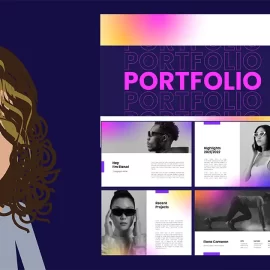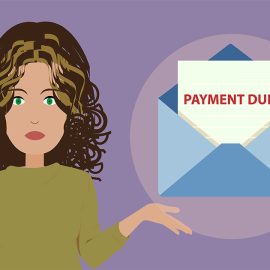
The A-Z of Portfolio Design
Every good designer has a portfolio, but not all portfolios are born equal. Some use single-page designs, showcasing everything they’ve done in one place. Others prefer to have separate pages dedicated to a particular task.
There are lots of different things you can include within a portfolio, which make it quite a challenge to craft the perfect design portfolio.
Here is an -Z guide explaining the features that every showcase of your skills should not be without.
A is for Achievements
If you’ve ever won an award for your design skills or articles showcasing the best of design, it’s definitely worth making a note about it on your website. While the value of these mostly made up ceremonies is questionable, the fact you’ve been included shows that people appreciate the effort you’ve put into your work.
Don’t submit yourself to every website you can find though, as that will diminish the value you get from being legitimately included on the basis of quality workmanship.
B is for Browser support
There is no excuse for your work not being available to certain visitors. It doesn’t matter if someone is using a forsaken browser, every user of your website could be a potential client.
There are plenty of emulators, testing services and resources to help you get a handle on the ever growing field of rendering engines. So be sure not to end up as one of those people who unhelpfully tells visitors to upgrade their browser or go away!
C is for Case studies
Having some pretty screenshots on your websites is useful, especially for websites that are no longer available. But why stop there?
A growing trend among designers is to attach a case study with each client project they undertake. It almost certainly takes more time to produce, but showing your creative process not only helps clients establish if your methods will match their vision, but it also showcases your abilities beyond what a simple image can offer.
D is for Disciplines
Every designer and developer is unique, possessing a varying range of skills and abilities.
As part of a good portfolio, it’s important to describe precisely what services you offer and what you’re willing to offer clients.
While you shouldn’t make a list of all the things you don’t know, or aren’t confident in using in a live project, be sure to explain where you excel and what it means for potential clients. After all, you don’t want to waste peoples’ time.
E is for Employment
If you’re setting up a portfolio in conjunction with your work for a business, you should say where you’re working. It could not only lead to further work for that business, but it may also positively reflect upon you as an employee, should you ever want to freelance (or build side projects) in your spare time.
If you are a freelancer, list only relevant industry-related places you’ve worked before. If you attended university, you should also list that separately giving details of what you studied, where you studied it and what you achieved.
F is for Frequency
Keeping your portfolio up to date is quite possibly one of the most important things you can do for your image, and it’s something far too many designers neglect.
While you certainly may be busy with client work, try to post updates whenever you get a free moment. This can be in the form of blog posts, case studies, some new features or some useful refinements to your website.
If your website becomes stale, you might find that opportunities dry up as time goes by and no one wants to appear like they’ve abandoned their homepage.
G is for Gravitas
One thing that annoys many people in the industry is how some designers and developers portray themselves on their website. While certain portfolios showcase a subtle sense of humour and it works well, calling yourself a ninja or hyping yourself up as a world-class code monkey won’t win you many fans.
Web design is an industry and a profession, and as such, your portfolio should reflect that. You don’t have to be dry or boring, but be careful not to overdo your statements, otherwise you’ll appear egotistical and not an ideal partner to certain clients.
H is for Happy medium
One of the most popular designer traits is the need for perfection. However, rather than just scrapping a design because you’ve gone through revision 37 and still feel it’s not quite right, consider that it doesn’t need to be polished or perfect to be launched. It just needs to be at a happy medium.
I is for Inspiration
Designing a portfolio can be hard work. As with client projects, you have an almost endless array of choices to make and potential pitfalls to fall into.
While some people prefer not to use inspiration galleries as references for gaining a few ideas, examining the work of others can inspire you to do more with your own. It’s worth checking how others achieved success to motivate yourself.
J is for Just enough
When it comes to any portfolio, content is king. Yet, while you can certainly make the mistake of saying too little and leaving people asking questions that should have already been answered, you can also go too far and say too much.
When a client visits your website, they probably don’t want to learn your life history. In most cases, the first thing they want to see is your portfolio, and then get to know you better.
As such, it pays to proofread your content and ensure it’s not only well written, but that it can be glanced through as a light read for those in a hurry.
K is for Kudos
Have you ever gotten some great feedback from clients? What about other designers or developers you’ve collaborated with? Maybe even a previous employer at your last design studio job? If so, asking politely for some reviews to include on your website could be invaluable.
For those giving the reviews, it’s a chance to leave some useful feedback and score another link on your website. For future clients, it’s a great opportunity to gain some insight about your work practices that they wouldn’t necessarily get from a case study or elsewhere within the portfolio.
L is for Limit tests
While you should ensure that your website works correctly, a personal portfolio is one of the few places where you can push your knowledge of web technologies to the limits.
Experimentation is a key part of showcasing your abilities – and while you may not be able to be as playful with another person’s website – your portfolio is the best opportunity you’ll have to highlight your talent for crafting unique and interesting designs. You don’t have to do anything superhuman or over the top, but it’s worth trying for something that visitors will appreciate.
M is for Mobile
Responsive design is here to stay and because of this, no portfolio has an excuse for using fixed width layouts or having a design that refuses to scale correctly on mobile devices.
While it’s surprising that it still happens, you really want to ensure that your portfolio functions in as many environments as possible, as the number of users of handheld devices continues to escalate worldwide. After all, your next potential client could be on a train, traveling to work and trying to find a designer like you on their mobile device.
N is for Navigation
Information architecture is not to be underestimated and your portfolio should do everything it can to ensure a potential client won’t get lost trying to find information on your website.
Ensure that visitors don’t have to click too many times to reach a destination (3 clicks is an ideal maximum). Also, always label pages using the terminology and naming conventions that other portfolios use, to ensure that sections can be easily identified.
Navigation matters, so don’t neglect your menu structure.
O is for Optimisation
Aside from compatibility, performance plays an ever increasingly important role in our workflow.
With many users giving up if a website won’t load within 3 seconds and connectivity issues plaguing many online experiences, you should optimise your portfolio so that it will get in front of a visitor’s eyes as quickly as possible.
P is for Projects
If you’ve built a cool framework, a useful web app, or even if you’re involved in an open source project, these are things which should also be included in your portfolio.
While you may not have made them for a paying client, the time and effort you’ve put in to them could encourage clients to come forward and hire you. If you’re not working on personal projects, perhaps you should when you have a slow patch, as it all helps to build up your body of work.
Q is for Quotes
One of the keys to a successful portfolio is communication. While many designers choose to simply list their email address, phone number or a form that contains little more than a name, email and message request, there is a lot of ambiguity that could unsettle a possible client.
Rather than sending several emails trying to interpret their requirements past that initial contact, consider adding a project planner to your portfolio to identify their needs. If nothing else, it will help you weed out “unsuitable” client requests.
R is for Resume
If you’re building a portfolio, you should also provide a resume for potential employers or clients to save as a quick reference. Whether you provide it as HTML or PDF, is entirely up to you.
However, when it comes to giving visitors a simple and effective overview of everything you’ve discussed on your website, avoiding any clutter or non-worthy highlights is imperative. Most people will only glance and scan a document before reading it properly. Having a simplified version of all the data included in your portfolio could be a handy and useful bonus feature.
S is for Social
If you get an email from someone on your portfolio, try to answer it as quickly as possible. Many of us are guilty of forgetting to reply, and it’s true that finding the time to respond to everyone is increasingly difficult. However, when it comes to client work, you don’t want to risk losing out on a special project because you couldn’t find the time to respond, as you were too busy writing a blog post.
You should also have an active presence on social media platforms and post regularly, as it’s a great way for clients of the future to track your progress.
T is for Timeframes
If you have months without client work, it’s not an ideal situation, and getting a constant flow of projects can be difficult.
To overcome this issue, many designers list their schedule on their portfolio. Adding a progress report with the availability you have to timetable large, medium or small projects would be informative for clients who desperately want your skillset. You could just say “I’m fully booked”, or go into more detail if you prefer.
U is for Usability
If your website is easy to use, people will enjoy browsing it. If they enjoy using your website, potential clients are more likely to believe you’ll give them something their customers will approve of.
It’s also very important that you make your website accessible. Your portfolio might be encouraging all sorts of people to your website, and if a client finds themselves unable to work through your design, you will likely regret it.
V is for Validation
When it comes to your portfolio, you can be sure that your work will be under added scrutiny and your source code will likely be the first thing that savvy clients examine.
If your source code is well formed, it will reflect positively on your image. After all, the care you’ve put into your code is a likely sign of what’s to come.
W is for Workflow
We all have our own methods of building a website and there’s no right or wrong way to get there (just as long as the website works and functions well).
One thing all portfolios should consider including, is a page or section of your website that declares your workflow and how your particular design process will affect clients. You don’t need to include a huge amount of detail. However, you don’t want to leave people in the dark about how you do business and the things they should expect and be expected to undertake, as part of the development journey.
X is for X-Factor
No two portfolios should look alike, yours included. So many websites seem to end up as clones of some trend-setting portfolio and it’s a shame to see such a lack of imagination.
You might initially think that it probably doesn’t matter, as the client won’t find out the truth. But it’s likely that as you went on a hunt for ideas before building your design, clients will have also had a good sniff around to find a client that they like the look of.
You are trying to sell your services, as being unique as possible. So give your site the X-factor and don’t be a cheap knockoff!
Y is for You
A portfolio is about a business or a person. In either case, every portfolio should include some information about the people running it.
If you are running a studio or agency, don’t just list the CEO or creative directors. Give every employee some space on the page. Give them a brief introduction, link to their social profiles, even include a link to their website, if possible.
Clients who want to understand the value behind the company, will likely look at that page of employees and want to know a bit about the skillset of each person contributing to their project.
Z is for Zesty
If there’s one thing you need to succeed in business, it’s positivity. There will be times when things go wrong, and certainly nobody is perfect. However, reflecting that in your portfolio is an important message to have.
People want to hear positive things about the company. They want to know about your successes, goals and ongoing heroics. While you shouldn’t overplay the card and make yourself appear egotistical, ensure your website is worded positively, rather than negatively. You don’t want to put clients off with tales of burnout or regrets.
Conclusion
A portfolio isn’t a place to dump your resume, nor is it something to neglect. It’s a website that should be at the very centre of your universe. It represents your head office; where new clients can find and potentially hire you for your skills.
By making some tweaks to your current layout, content or code, it could make a real difference to your business.
SOURCE: Onextrapixel



